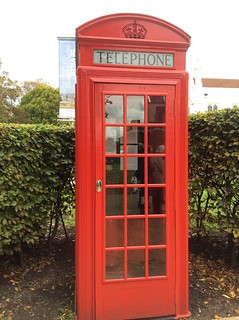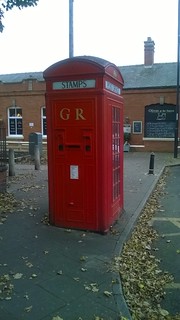The History of The Telephone Kiosk
History
In 1921, the first standard kiosk appeared, the K1. The K1 was intended for rural areas and was made of concrete.
In the late 1920's the Royal Fine Arts Commission on behalf of the GPO invited a few people to design a new kiosk.
In 1926 the chosen design appeared, Giles Gilbert Scott's K2. The K2 was of cast iron construction and a few hundred remain today
 K2 still in service today outside the Dulwich Picture Gallery, Gallery Rd, London SE21 7AD
K2 still in service today outside the Dulwich Picture Gallery, Gallery Rd, London SE21 7AD
The K2 was too big and too expensive for mass production. The GPO wanted a
new design and asked Sir Giles to produce another design, in 1929 the K3 appeared, a smaller,
concrete version of the K2.
In 1927, the K4 was intended to be a 24-hour post office with a stamp machine and
letterbox added to the back. It was nicknamed the Vermilion Giant and was a fantastic failure with
only 50 produced.
 K4 still in operation in Whitley Bay
K4 still in operation in Whitley Bay
In 1934, a K5 was produced, made of plywood as a temporary kiosk for use at
exhibitions and fairs etc.
With problems occurring with the K3, a new cast iron box was needed and in 1936 the K6 appeared
for the first time on the streets. The kiosk was perfect, it had all the good points of the K1 and K3
mixed with the solidness of the K2 and most importantly, the small size and elegance the Post Office
were looking for. The K6 also known as the 'Jubilee kiosk' was widely used to replace K1's and K3's.
In the 1960's the Post Office were considering a new design. Neville Conder's design for a K7 was
chosen. It was made in aluminium and was tested in 1962. The K7 was not adopted as a new design
and only five were made.
In 1965, another competition was held to design a new kiosk, the K8. Bruce Martin was the winning
architect and his design appeared in 1968. It was a very new design to the previous ones. The main
differences were that the glazing bars had gone to be replaced with just one big window on each
side of the kiosk and the domed roof was replaced with a much flatter design. Nearly 4,000 K8s
would appear, some of which replaced K6s. Vandalism was always a problem with telephone boxes
and during the 1970's British Telecom made another modification to the K6, many kiosks had their
glazing bars ripped out and had a single piece of glass put in like the K8.
The K6 Red Phone Box

In 1935 the K6 Red Phone Box (kiosk number six) was designed to commemorate the silver jubilee of King George V.
The K6 was constructed from cast iron, except for the door which was teak. Its door and adjacent sides were glazed, the K6’s windows comprised a broad central pane with narrow ones either side organised in eight rows. The top of the K6 comprised of a telephone sign on opaque glass, a moulded Royal crown and a domed roof. A test prototype was installed in London in December 1935 and by February 1936 supplies of this new kiosk started to arrive
K6 was the first red phone box to be used extensively outside of London, kiosks were provided to every town or village with a post office, regardless of cost. As a result of this scheme 8,000 new kiosks had been installed by the end of 1936. By the end of the 1930’s over 20,000 K6 kiosks had been installed countrywide.
In 1939 The Royal Fine Arts Commission endorsed a policy of painting the kiosks red in all locations. The red colour caused particular local difficulties and there were many requests
for less visible colours. The red that is now much loved was then anything but, and the Post Office
was forced into allowing a less strident grey with red glazing bars scheme for areas of natural and
architectural beauty. Ironically, some of these areas that have preserved their telephone boxes have
now painted them red.
Also in 1939 the K6 (Mk II) was introduced which had more secure windows and phone mounting points. The windows were being stolen to make cole frames for growing vegetables and the cashboxes could be easily prised off in the MK I kiosks.
The MK II kiosks also had a slightly different design on the royal crown, MK I crowns had a flat base and the MK II crowns had more shape to the base of the crown.
Buy K6 Crowns here
All kiosks installed prior to 1955 were produced with the Tudor Crown of George V. After 1955 the crown in the kiosk was changed to the St Edwards Crown and in Scotland the Scottish Crown. Between 1955 and 1965 the K6 kiosk were produced with a slot where the crown was to go so that either the St Edwards Crown or the Scottish crown could be used.
The K6 was the most prolific kiosk in the UK and its growth, from 1935, can be seen from the BT. In total around 65,000 K6 kiosks were installed.
archives:
- 1925 - 1,000 (K1 Only)
- 1930 - 8,000 (K2 and K3 Red Phone Boxes added)
- 1935 - 19,000 (K6 Red Phone Box introduced)
- 1940 - 35,000
- 1950 - 44,000
- 1960 - 65,000
- 1970 - 70,000 (K8 Red Phone Box introduced in 1968)
- 1980 - 73,000
The K6 Kiosk can be found with three different crowns. K6 Kiosks produced until around 1955 were produced with the Tudor Crown of George V. The first kiosks that were produced had a Tudor Crown with a flat bottom this was later changed to show more detail.
After 1955 the crown in the kiosk was changed to the St Edwards Crown and in Scotland the Scottish Crown.
Between 1955 and 1965 the K6 kiosk were produced with a slot where the crown was to go so that either the St Edwards Crown or the Scottish crown could be used.
K6 Red Phone Box Facts
- The K6 or "Jubilee Kiosk" commemorates the Silver Jubilee of the coronation of King George V.
- Kiosk No 6 was designed by Sir Giles Gilbert Scott, who also designed Liverpool's Anglican Cathedral, Battersea Power Station and Bankside Power Station now Tate Modern
- Sir Giles also designed the K2 and K3. The K4 kiosk was developed by the Post Office Engineering Department based on the K2 design.
- The K6 was the first kiosk installed nationwide and the standard kiosk across the UK until the introduction of the K8 in 1968
- The K6 kiosk is made from cast iron with a teak door. It is 8'3" tall (2.4 metres), 3' wide (0.92 metres) and weighs three quarters of a ton (762 kilograms)
- The K6 design was approved by the Post Office and the Royal Fine Arts Commission, which endorsed "Post Office red" as the standard colour
-
Although Scott agreed to the use of "Post Office red" he was never a supporter of the colour and initially suggested the outside of the
kiosk be painted silver and the inside greenish-blue. He strongly urged rural kiosks be painted dove-grey
- Two K6 kiosks were installed in France during 1995, for the 50th anniversary of the D-Day landings
- Two red K6's have been transformed into combined payphones and cash machines